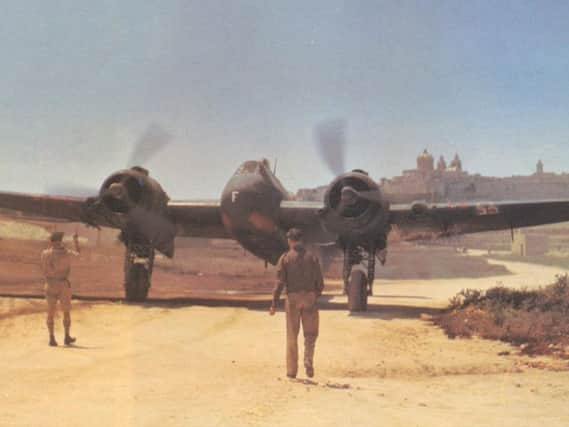Wacker's war saw him in North Africa and the Mediterranean


It was 1986 and Sid and some of his family were having a drink in the Maypole pub in the Sussex Wealden village of High Hurstwood. He told me he had had a serious flutter on Desert Orchid to win that afternoon’s King George Chase at Kempton Park. I failed to heed his advice and missed out on the grey pinging over the fences to romp home at an amazingly generous 16-1. More fool me. At the time I didn’t know that Sid had served in the North African desert in World War II and being someone who loves a coincidence bet I missed out double time.
Sidney Wickens (nicknamed “Wacker”) joined the RAF in October 1938 aged 21. After failing a pilot's eye test he trained as a fitter, joining 272 Squadron RAF in November 1940. He sailed from Liverpool in a convoy escorted by HMS Rodney bound for Egypt via South Africa. The customary “Dipping and Ducking” ceremony was performed when he crossed the Equator for the first time.
Advertisement
Hide AdAdvertisement
Hide Ad272 Squadron operated Bristol Beaufighters escorting convoys and making fighter patrols over the Med. Sid was based for a while at Edku in Egypt. It was a critical period of the desert war and Sid experienced sad times when they were regularly losing aircraft and crews. On leave he visited Cairo but always regretted he never got to see the pyramids.
Life on a desert airfield was very basic with baking heat in the day and extreme cold at night. Sand and engines don’t mix and it was a constant battle to keep the aircraft airworthy. The ground crews were adept at improvising; Sid and some pals once found a burnt out lorry in the desert, hauled it back to camp and spent many hours kitting it out for living quarters. The Medical Officer waited until they had finished the job and then commandeered it for use as a sick bay!
Ever resourceful, Sid once set up a contraption for heating one of the water tanks so that the lads would always have hot water for washing. One day the device backfired and Sid received burns to his face, lost his eyebrows and the fringe of his hair. He was put on a charge and given extra cleaning duties in the officers’ mess.
Following major repairs, fitters frequently went on test flights with pilots to check on their handiwork. On one such flight Sid found that the original problem had been fixed only for the undercarriage to fail forcing the pilot to make a crash landing. As Sid was in the well of the plane the pilot advised him to elevate his legs or risk them being broken on impact. Once on the ground, Sid left the plane pronto knowing that it could burst into flames at any moment. For this he was put on another charge (more cleaning) for leaving the aircraft faster than the pilot!
Advertisement
Hide AdAdvertisement
Hide AdThe North African desert wasn’t always dry. One day Sid’s unit pitched their tents in a wadi; unluckily for them it rained for the first time in years and a flash flood swept away all their accommodation. It was some time before new tents arrived from Britain and when they did they were khaki and green not cream-coloured to blend in with the sand.
Another time Sid received a telegram saying that his brother, Stanley, had been injured and was in hospital many miles away. The CO granted him two days leave. Sid cadged a ride in an aircraft for part of the way but had to walk the last six miles. He arrived in the early hours of the morning only to be informed that his brother was now fit and indeed had been back at the front with the Eighth Army for a month. The telegram had been hopelessly out of date. The next time Sid saw Stanley was in Italy after his brother had taken part in the fierce fighting around Monte Cassino in the first half of 1944.
Following a brief spell in Cyprus, in November 1942 Sid was posted to Tal Qali airfield on the much-bombed island of Malta. In February 1944, 272 Squadron moved to Alghero in Sardinia from where they attacked enemy shipping.
With the war over in Italy, 272 Squadron RAF disbanded on 30th April 1945. They were credited with destroying 185 enemy aircraft and damaging many more, sinking 68 ships, putting 832 transport vehicles out of action and wrecking a dozen trains.
Advertisement
Hide AdAdvertisement
Hide AdJust before sailing home in August 1945, Sid visited Rome. Then it was time for a reunion with the parents he hadn’t seen in four years. Subsequently he met and married Daphne and the couple had two daughters, Christine and Rosemary. After the war Sid worked on the estate of Lord Rupert Neville at Little Horsted near Uckfield. The Royal Family were frequent visitors.
How did I come to know Sid? His daughter Rosemary was best friends with my wife-to-be Barbara and we first met at the Little Horsted home of the Wickens in January 1971. Rosemary later married Barbara’s brother, Alan Huxley. Though it’s very sad that Sid passed away in 1991 I am pleased to record that Daphne continues to thrive.